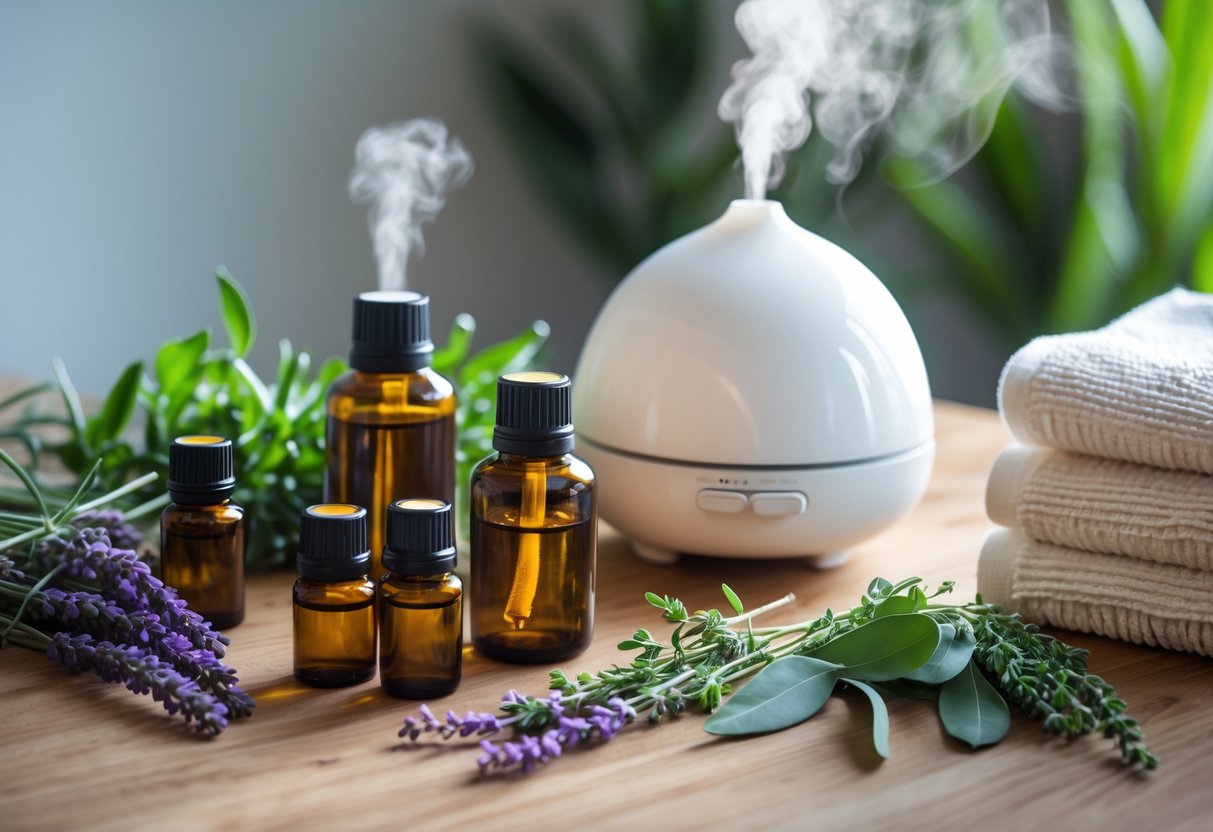Essential Oils For Beginners: A Friendly Guide To Getting Started

When you buy through links on our site, we may earn an affiliate commission at no additional cost to you (learn more)
Many people want natural ways to support health and create a calm home environment. Essential oils stand out because they offer simple methods to freshen a room, ease stress, and add pleasant scents to daily routines. Essential oils are concentrated plant extracts that can be used in small, safe amounts to support well-being and relaxation.
A beginner can easily feel unsure about where to start. With basic knowledge, choosing and using oils becomes simple and enjoyable. Learning about safe use, quality, and helpful blends makes it easier to enjoy their benefits with confidence.
This guide explains what essential oils are, how to begin using them, and how to apply them safely every day. It focuses on clear steps and practical advice so anyone can build confidence and form healthy habits with essential oils.
Getting Started With Essential Oils

Learning about essential oils starts with understanding what they are, how to pick good ones, and which oils are best for everyday use. With a bit of knowledge and care, anyone can begin using them safely and confidently.
What Are Essential Oils?
Essential oils come from plants through processes like steam distillation or cold pressing. These methods capture the natural scent and active compounds found in flowers, leaves, or roots. Each oil has a unique aroma and potential use, from calming the mind to freshening the air.
They are highly concentrated, so a little goes a long way. For example, a small bottle of lavender oil can represent pounds of harvested flowers. To use an essential oil safely on skin, people mix a few drops with a carrier oil such as jojoba, coconut, or almond oil.
Essential oils may be used in diffusers, bath products, or cleaning mixes. However, they should always be kept in dark glass bottles and stored in a cool, dry place. Proper storage helps protect their quality and scent.
How to Choose Quality Essential Oils
High-quality essential oils smell natural and are free of synthetic additives. When buying, it helps to check the label for purity and make sure it lists the botanical name (like Lavandula angustifolia for lavender). Transparency about the source and extraction method often signals a trustworthy brand.
Look for oils that state 100% pure essential oil and avoid those that list “fragrance oil” or “perfume oil.” These are often diluted or mixed with artificial ingredients. Reputable brands also share GC/MS test results, showing the oil’s chemical makeup and confirming that no fillers were added.
Packaging matters, too. Dark amber or cobalt glass bottles protect the oils from sunlight, which can break down their contents. Price can reflect quality but is not always proof of purity, so reading reviews and researching the company helps.
>>SHOP QUALITY BEGINNER ESSENTIAL OIL KITS<<
Popular Oils for Beginners
Some oils are easier and safer to start with than others. Lavender, peppermint, lemon, tea tree, and eucalyptus are popular choices due to their mild nature and wide range of uses.
- Lavender: supports relaxation and helps freshen indoor spaces.
- Peppermint: provides a cooling scent and can help boost alertness.
- Lemon: offers a clean, fresh aroma great for cleaning and diffusing.
- Tea tree: often used in skin care for its cleansing properties.
- Eucalyptus: known for its refreshing scent, often used in breathing blends.
Beginners can test these oils by diffusing a small amount or mixing them with carrier oils for topical use. Keeping notes on each oil’s scent and effect can make future choices easier.
Safe and Effective Use of Essential Oils
Using essential oils safely means knowing how to apply them, how much to dilute them, and how to store them correctly. Each step helps reduce irritation, preserve scent quality, and maintain effectiveness over time.
Best Methods of Application
People use essential oils in different ways depending on their needs. The most common methods are topical use, aromatherapy, and diffusion. For skin use, they should mix a few drops of an essential oil with a carrier oil such as coconut, almond, or jojoba before applying. This helps prevent redness or burning.
Diffusers spread the scent into the air, making a room feel calm or fresh. Only a few drops are needed for strong results. Inhalation can also be done by adding oils to a bowl of hot water and breathing in the steam.
Aromatherapy roll-ons and sprays offer easy use when traveling or at work. People should avoid applying undiluted oils directly on the skin and keep them away from sensitive areas like eyes and mouth.
Dilution and Safety Guidelines
Dilution depends on the purpose and type of oil used. For most adults, a 1–2% dilution works well for daily use. This means adding 1–2 drops of essential oil per teaspoon (5 mL) of carrier oil. For children, elderly users, or sensitive skin, the amount should be much lower—around 0.25–0.5%.
| Use Case | Dilution Ratio | Example |
|---|---|---|
| Adult daily use | 1–2% | 1–2 drops per 5 mL carrier oil |
| Sensitive skin | 0.5% | 1 drop per 10 mL carrier oil |
| Children | 0.25% | 1 drop per 20 mL carrier oil |
Some oils, like cinnamon or clove, are stronger and need extra dilution. People should also do a patch test before wide use. Applying a small amount on the inner arm and waiting 24 hours checks for possible irritation.
Pregnant or nursing individuals should talk to a health professional before use. Safe practices make essential oils more enjoyable and reduce unwanted side effects.
Tips for Storing Essential Oils
Light, air, and heat can break down the natural compounds in essential oils. They should be stored in dark glass bottles with tight lids to keep them fresh. Amber or cobalt blue bottles work best because they block sunlight.
Keep oils in a cool, dry place away from direct sunlight and heat sources. A drawer, cabinet, or refrigerator can extend shelf life. Avoid plastic containers since oils can dissolve the material over time.
Labeling each bottle with the purchase date helps track freshness. Most oils last 1–3 years, though citrus oils may expire faster. Regularly checking for changes in smell or color ensures the oils remain safe to use.



